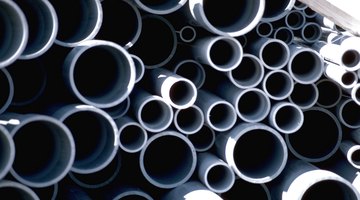How to Dig a Bell Hole for a Pipeline
A bell hole is not a hole excavated in the bottom of a trench; it's a widening of the trench over a given distance. The walls of the trench are benched away from the center-line of the trench.

This measure is taken to prevent a cave-in -- a result of sliding, toppling, tension cracked or bulging material -- from burying laborers. The United States Occupational Safety and Health Administration, or OSHA, provides strict guidelines for the proper excavation of bell holes. Though a bell hole requires more time to dig than the rest of the trench, excavating one is simple.
Things You Will Need
- Tape measure or grade rod
- Laser level
- Backhoe or excavator
-
Expand the bottom width of the trench threefold. The purpose of a bell hole is space in addition to safety. If the excavation of a bell hole is for the purpose of installing a valve, for example, a hole three times as wide as the trench gives laborers space for tools and supplies, and room to work around one another.
-
Calculate the depth of the trench with a tape measure or a grade rod. The depth of the trench determines the number of benches the bell hole requires or the starting point of the shore. OSHA requires one bench every 4 feet. As a result, a 16-foot deep trench requires a bell hole with three benches: one bench 4 feet from the bottom of the hole, another 8 feet from the bottom and another 12 feet above the bottom.
-
Excavate down the sides of the hole, 1 1/2 bucket widths wide, removing material from the walls. Stop removing material from the walls 4 feet above the bottom of the hole. The step created by this process, from the bottom of the hole to the surrounding walls, is the first bench.
-
Repeat the process; excavate down the sides of the hole -- again, 1 1/2 bucket widths wide -- removing material from the wall. Stop 4 feet above the first bench, or 8 feet from the bottom of the hole, for the second bench. Continue benching the hole until the final bench is 4 feet or less from ground level. Clean each bench. Remove any material that may have fallen as you excavated from above.
The Drip Cap
- A bell hole is not a hole excavated in the bottom of a trench; it's a widening of the trench over a given distance.
- The United States Occupational Safety and Health Administration, or OSHA, provides strict guidelines for the proper excavation of bell holes.
- Though a bell hole requires more time to dig than the rest of the trench, excavating one is simple.
- Repeat the process; excavate down the sides of the hole -- again, 1 1/2 bucket widths wide -- removing material from the wall.
References
Photo Credits
- Jupiterimages/Photos.com/Getty Images
- Jupiterimages/Photos.com/Getty Images
More Articles



